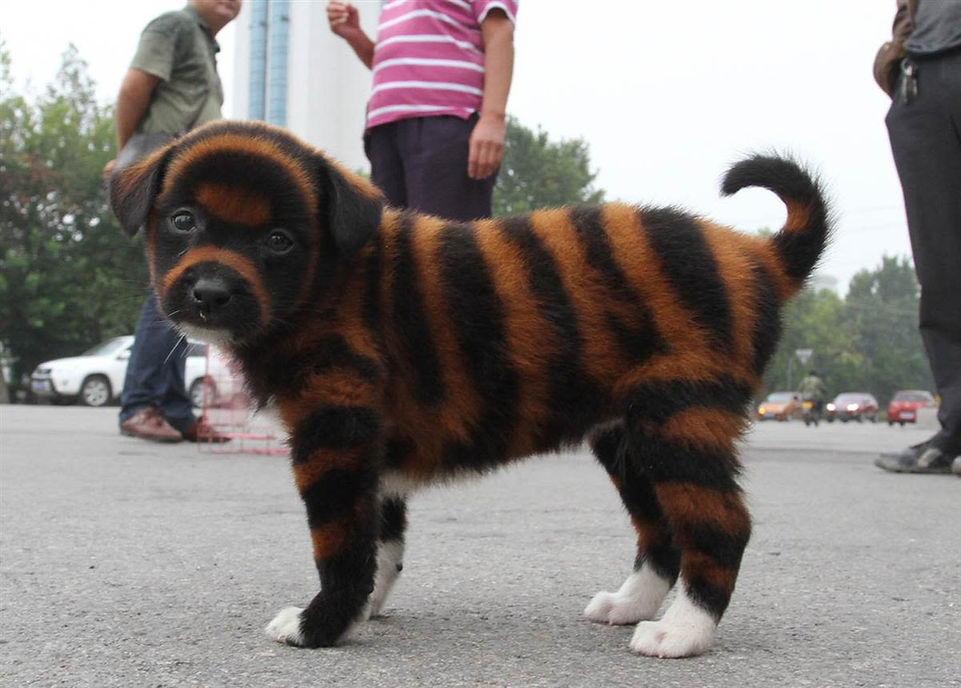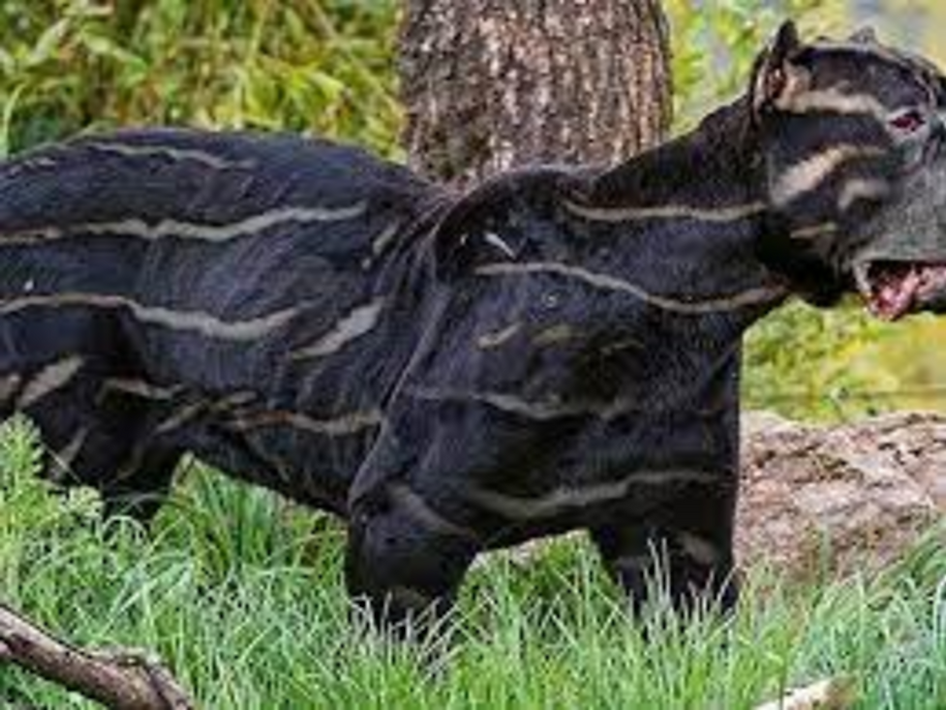Striped Dogs
Sharply Striped Dogs Do Not Exist
People are often surprised when I say that there is no such thing as a dog with distinct natural stripes. Pictures of dogs with zebra or tiger-like stripes can be easily found online, but none of these dogs were born with these patterns. Dogs depicted with sharply define stripes are created with dye or bleach, or a product of Photoshop. And where claims are made that the dogs are born this way (see "Chinese tiger dog"), it's simply not true.

Bleached or Dyed
There is a small market, notably in China but also in Japan, for dyed tiger stripe puppies. The gullible believe these are a natural breed. You will see them referred to as the Chinese or Japanese Striped Dogs. Most of them are made by bleaching black puppies rather than dying pale-colored puppies.
The height of this was around 2010 and it seems to have become less common in recent years. Sellers may claim the dogs are from a striped breed but the bleach stripes will fade away as the puppy grows and sheds. (And on the more sinister side, dog pelts with dyed stripes are also sometimes passed off as coming from more exotic animals.)
.jpg)
Painted
False claims about striped dogs are certainly not new. The story goes that Poochie, shown below, was born with these bold black and white stripes. But Poochie is a zebra dog in the same way Tijuana donkeys are zebra donkeys—his colors come out of a can.
This is clearly the kind of pattern a person would paint on an animal, not the type an animal of any kind would naturally grow. If any credible journalist believed this shaggy dog story, well, I guess maybe those were simpler times.

Manipulated Photographs
In 2022, several "click bait" articles suggested a muscular striped dog (shown below) was a rare breed. As Snopes showed, this was actually a picture manufactured by combining a black panther and dogs, and then stripes were added.
Non-Toxic Paint Can Create a Harmless Costume
People also sometimes give dogs temporary stripes as part of a tiger or zebra costume. Maybe for Halloween, to emulate a sports mascot... or just for the heck of it.
However some people persist in including dogs with obviously painted stripes on lists of dogs with interesting natural-born coloration patterns. The only natural stripe pattern found in any breed of dogs has a very different appearance—the brindle, as shown below.
.jpg)
Source: Foter / Creative Commons Attribution-ShareAlike 2.0 Generic (CC BY-SA 2.0)
A Naturally Striped Dog Is Brindle
Many breeds of dog show diffuse black lines often with a black mask. Brindle coats are sometimes referred too as "tiger striped." In reality the stripes are much less defined. Brindle coats have mottled, not sharply defined, streaks that are mostly black (eumelanin) or mostly brown (phaeomelanin).
With dilution factor the colors may be expressed in paler grey or fawn colors. Brindle has been shown to be caused by the expression of a single gene in breeds such as the boxer, greyhound, and French bulldog.
.jpg)
The closest to a true stripe I have seen in a brindle is Molly, a female Akita in the Netherlands, pictured here in 2007. Source: Peter Theakston
Weimaraner Puppies
One other unusual presentation of stripes is in Weimaraner puppies, who have pale tan or gray stripes for just the first few days after they're born.
.jpg)
Source: Carlos Huerta
Exotic Dogs
If you look outside of the domesticated dog, there are other species of canid that naturally have stripes. These include the African wild dog (Lycaon pictus) and hyena, as well as other dog-like animals, i.e., the Australian thylacine (a.k.a. Tasmanian tiger).
Text
Citations
-
Ross D Clark, D. V. M. (2014). Medical, Genetic & Behavioral Risk Factors of Weimaraners. Xlibris Corporation.
-
Schmutz, S. M., & Berryere, T. G. (2007). Genes affecting coat colour and pattern in domestic dogs: a review. Animal genetics, 38(6), 539-549.
-
Schmutz, S. M., Berryere, T. G., Ellinwood, N. M., Kerns, J. A., & Barsh, G. S. (2003). MC1R studies in dogs with melanistic mask or brindle patterns. Journal of Heredity, 94(1), 69-73.
See Also:
-
Tiger-dog-reptile-alien | The House of Two Bows 雙寶之屋
I love this "dog," if indeed that's what it is... I love the idea of this creature, a barely mammalian, tiger-striped, sighthound-shaped hybrid that is as wild as its coat pattern and alien face.